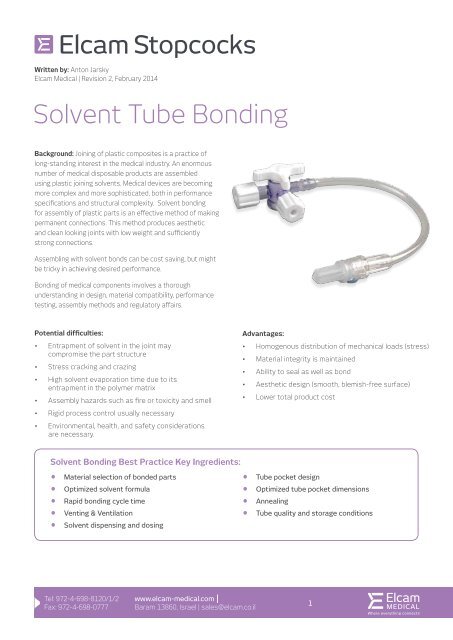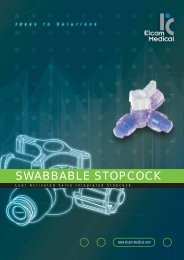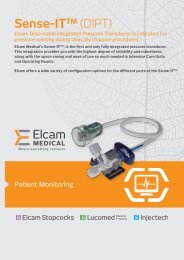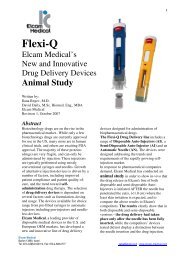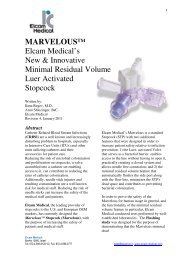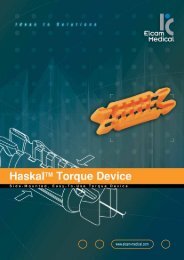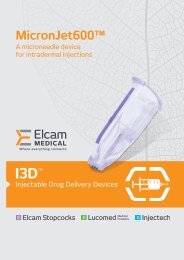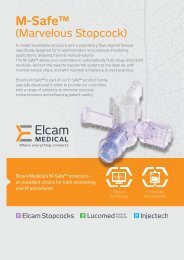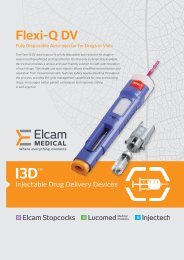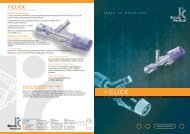Solvent Tube Bonding - Elcam Medical
Solvent Tube Bonding - Elcam Medical
Solvent Tube Bonding - Elcam Medical
- No tags were found...
Create successful ePaper yourself
Turn your PDF publications into a flip-book with our unique Google optimized e-Paper software.
Written by: Anton Jarsky<strong>Elcam</strong> <strong>Medical</strong> | Revision 2, February 2014<strong>Solvent</strong> <strong>Tube</strong> <strong>Bonding</strong>Background: Joining of plastic composites is a practice oflong-standing interest in the medical industry. An enormousnumber of medical disposable products are assembledusing plastic joining solvents. <strong>Medical</strong> devices are becomingmore complex and more sophisticated, both in performancespecifications and structural complexity. <strong>Solvent</strong> bondingfor assembly of plastic parts is an effective method of makingpermanent connections. This method produces aestheticand clean looking joints with low weight and sufficientlystrong connections.Assembling with solvent bonds can be cost saving, but mightbe tricky in achieving desired performance.<strong>Bonding</strong> of medical components involves a thoroughunderstanding in design, material compatibility, performancetesting, assembly methods and regulatory affairs.Potential difficulties:• Entrapment of solvent in the joint maycompromise the part structure• Stress cracking and crazing• High solvent evaporation time due to itsentrapment in the polymer matrix• Assembly hazards such as fire or toxicity and smell• Rigid process control usually necessary• Environmental, health, and safety considerationsare necessary.Advantages:• Homogenous distribution of mechanical loads (stress)• Material integrity is maintained• Ability to seal as well as bond• Aesthetic design (smooth, blemish-free surface)• Lower total product cost<strong>Solvent</strong> <strong>Bonding</strong> Best Practice Key Ingredients:• Material selection of bonded parts• Optimized solvent formula• Rapid bonding cycle time• Venting & Ventilation• <strong>Solvent</strong> dispensing and dosing• <strong>Tube</strong> pocket design• Optimized tube pocket dimensions• Annealing• <strong>Tube</strong> quality and storage conditionsTel: 972-4-698-8120/1/2Fax: 972-4-698-0777www.elcam-medical.comBaram 13860, Israel | sales@elcam.co.il1
Material selection• Determining factors to be generally observed- mechanical and physical properties of bonded-jointrequirements.• Polymer selection (1) – <strong>Solvent</strong> bonding is applicable only with amorphous polymers such asPolycarbonate, PVC or Polystyrene• Stress cracking is more prevalent in low molecular weight polycarbonates;• It is therefore recommended to select polycarbonates with higher molecular weight which havebetter resistance to solvent-induced cracking.Optimized solvent formula• The most common solvents for bonding of medical plastic parts is based on Cyclohexanon orMethylene Chloride, usually mixed in different formulas and ratios with other ingredients. Recentconcerns about Methylene Chloride health effects have led to a search for alternatives in many ofthese applications.• Basically it is known that Cyclohexanone and other solvents might urge stress cracks.The use of 100% Cyclohexanone is not recommended. It can be mixed in a ratio of 50:50 withMethyl Ethyl Ketone(MEK) and the solvent cement can be further bodied up to 25% by weight withthe parent plastic (of the tube) to increase viscosity. By most part PVC or PUR pellets are addedto the solvent formula to the above ratio. That kind of bodied solvent cement can fill gaps (2), andprovides less shrinkage and internal stress than if only pure solvent is used.Venting & Ventilation• Good aeration to allow solvent vapors release from the product is critical. While the productsare drying all ports should be open. It is not recommended to bond while ports are closed, as novaporization is possible this way. Good ventilation is an essential requirement and exhaust hoodsare highly recommended. This evaporation process also results in the continuous thickening of thesolvent mix at solvent reservoir. That means that it must be replenished from time to time.• Any kind of bonding agent has the potential of urging stress cracks if proper aeration and drying isnot performed adequately.• Products should be left for complete solvent evaporation for at least 24 hours (3). This is extremelyimportant in order to avoid internal stress and crack evolvement. It is not recommended to testbonding strength, sterilize or pack the products during that period.Tel: 972-4-698-8120/1/2Fax: 972-4-698-0777www.elcam-medical.comBaram 13860, Israel | sales@elcam.co.il2
VentilationEnsure adequateventing• In case of a male luer lock connector bonding to a stopcock, over torque of the connector over theIn case protectors (caps or covers) must be assembled before the end of the bonding and dryingstage, it is strongly recommended to use Vented protectors in order to enable vaporization of thebonding agent vapors.<strong>Solvent</strong> dispensing and dosing• Excess of bonding agent coming in contact with the body material maycause cracks and should be avoided. <strong>Solvent</strong> trapped inside a joint maylead to porosity and weakness. Only the minimum amount of solvent, toallow proper bonding should be used (2).• It is advised to perform the bonding process by using a dispensing device.For other processes, attention must be taken to absorb the excess solventfrom the tube very carefully, after dipping it in the solvent.• If excess solvent is present, it is most important that it will not reachthe stressed parts, so probably the best way is to aerate the productshorizontally positioned.• When bonding a tube (to a stopcock or another component) it is highlyrecommended to hold the tube below the stopcock (stopcock’s male luerpointing downward) and leave it for at least two hours after the bondingin this position.Tel: 972-4-698-8120/1/2Fax: 972-4-698-0777www.elcam-medical.comBaram 13860, Israel | sales@elcam.co.il3
Fitment port design & Optimized fitment port dimensions• The fitment port should be designed to comply with the tube’s dimensions and material. Optimizedjoint geometry will reduce manufacturing cycle time, assembly forces and disqualificationpercentage. It will also reduce the risks for disconnections and cracking (4).• Plastic injection molding of some fitment geometries might introduce residual internal stresses,that when comes in contact with organic solvent bonding agents might crack.• Efforts to reduce stress concentrations formed at the bond-line ends of joints may include the useof tapered or beveled external scarf and radius fillets at the bond-line end.• It is usually recommended to design a tapered excess solvent trap at the fitment port inlet toallow containment of excessive solvent (3). (see drawing 1)drawing 1• Fillet at the edge of the bond achieved by internal taper on the inlet thickens the bond-line thusreducing shear stress concentration by separating the strain over a larger dimension.(see drawing 2 and 3)drawing 2 drawing 3Tel: 972-4-698-8120/1/2Fax: 972-4-698-0777www.elcam-medical.comBaram 13860, Israel | sales@elcam.co.il4
• It is important to cut the tube square. A square cut provides the surface of the tube with themaximum bonding area and may leave larger area for excess of solvent which is poorly ventilated.SOLVENT BONDBond LineTUBE POKET DESIGNAnnealing• Stress cracking or crazing is the formation of microcracks on the surface of a plastic part that hasresidual internal stresses due to its molding or assembly process. The contact with a solvent willcause the stresses to release uncontrollably resulting in stress cracking of the part. When this is theproblem annealing the plastic components (prior to their assembly) can reduce the level of residualstresses and improve the joint resistance to cracking.• Temperature and time should be chosen according to the thickness and weight of the molded part (2).• The annealing process should be conducted by a properly validated equipment and method that willensure an exposure to an equal amount of heat for every component.• It is recommended to use forced air circulation oven with tight temperature and time control whenannealing plastic parts, otherwise temperature variation may occur and parts may be damaged orleft un-annealed.• The annealing temperature must be lower than the plastic’s glass transition temperature (marked Tgin the plastic’s data sheet).• The annealing process might introduce undesired trade-offs like surface brittleness anddeformations. If possible it is recommended to avoid the need for annealing by optimizing the joint’sgeometry, material and molding process (5).<strong>Tube</strong> Quality and Storage Conditions• <strong>Medical</strong> grade PVC tubing is commonly used in medical devices because it is versatile but it issomewhat sensitive and usually requires special handling procedures that are important to maintainthe dimensional tolerances and physical properties• Commercially available PVC is highly branched and has low crystallinity. Since the reliability of bondsin medical device is of utmost importance it is recommended to use PVC with higher molecularweight (K-Value >100 with number average molecular weight up to 150,000)which has a number ofadvantages, such as more ordered structure, more linearity, higher degrees of crystallinity, and highermechanical strength.• It is important that bonded parts do not undergo physical or chemical changes whilst being stored.Hence it is advised that parts be stowed in orderly pattern- lengthwise /crosswise grid or otherinterlocking pattern, while maintaining good horizontal alignment in a packaging unit to eliminateall types of physical strain on the bonded area.Tel: 972-4-698-8120/1/2Fax: 972-4-698-0777www.elcam-medical.comBaram 13860, Israel | sales@elcam.co.il5
• Moisture can alter the chemistry of both the surface and substrate of the bonds, thus compromising the performanceof bonded joints.References:1. Applied Adhesive <strong>Bonding</strong>. (2009) Gerd Habenicht.2. Handbook of adhesives and sealants. (2004) Edward M. Petrie. McGraw-Hill.3. Handbook of plastics joining (A Practical Guide). (1997) Plastics Design Library.4. Joining of plastics. (Handbook for designers and engineers); Jordan Rotheiser.5. Influence of processing and subsequent annealing on the ductile-brittle transitionin PC. (2006) M.C.G van Zuilichem.Tel: 972-4-698-8120/1/2Fax: 972-4-698-0777www.elcam-medical.comBaram 13860, Israel | sales@elcam.co.il6


